Related Research Articles
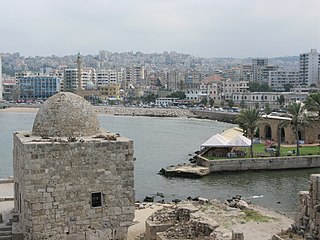
Sidon or Saida is the third-largest city in Lebanon. It is located in the South Governorate, of which it is the capital, on the Mediterranean coast. Tyre to the south and Lebanese capital Beirut to the north are both about 40 kilometres away. Sidon has a population of about 80,000 within city limits, while its metropolitan area has more than a quarter-million inhabitants.
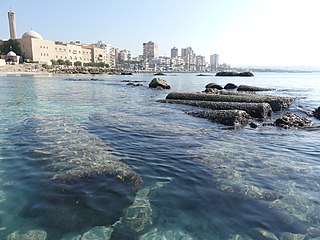
Tyre is a city in Lebanon, one of the oldest continually inhabited cities in the world, though in medieval times for some centuries by just a small population. It was one of the earliest Phoenician metropolises and the legendary birthplace of Europa, her brothers Cadmus and Phoenix, as well as Carthage's founder Dido (Elissa). The city has many ancient sites, including the Tyre Hippodrome, and was added as a whole to the list of UNESCO World Heritage Sites in 1984. The historian Ernest Renan noted that "One can call Tyre a city of ruins, built out of ruins".

Beirut is the capital and largest city of Lebanon. As of 2014, Greater Beirut has a population of 2.5 million, which makes it the third-largest city in the Levant region and the thirteenth-largest in the Arab world. The city is situated on a peninsula at the midpoint of Lebanon's Mediterranean coast. Beirut has been inhabited for more than 5,000 years, making it one of the oldest cities in the world.

The American University of Beirut is a private, non-sectarian, and independent university chartered in New York with its campus in Beirut, Lebanon. AUB is governed by a private, autonomous board of trustees and offers programs leading to bachelor's, master's, MD, and PhD degrees.

The culture of Lebanon and the Lebanese people emerged from various civilizations over thousands of years. It was home to the Phoenicians and was subsequently conquered and occupied by the Assyrians, the Greeks, the Romans, the Persians, the Arabs, the Crusaders, the Ottoman Turks and the French. This variety is reflected in Lebanon's diverse population, composed of different religious groups, and features in the country's festivals, literature, artifacts, cuisine and architecture of Lebanon. Tourism in Lebanon is popular with periods of interruption during conflict.
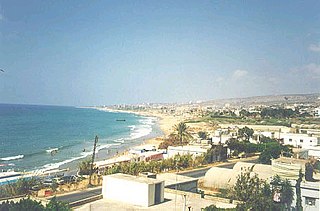
Jieh is a seaside town in Lebanon with an estimated population of 5000, 23 km south of Beirut, in the Chouf district via a 20-minute drive along the Beirut to Sidon highway south of the capital. In Phoenician times it was known as Porphyreon and was a thriving natural seaport, which still functions today. The town is also known for its seven kilometre sandy beach, a rarity along Lebanon's mainly rocky coastline.
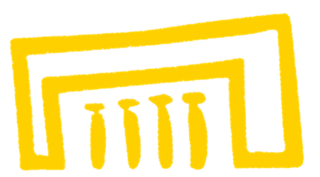
The National Museum of Beirut is the principal museum of archaeology in Lebanon. The collection begun after World War I, and the museum was officially opened in 1942. The museum has collections totaling about 100,000 objects, most of which are antiquities and medieval finds from excavations undertaken by the Directorate General of Antiquities.

Archaeology of Lebanon includes thousands of years of history ranging from Lower Palaeolithic, Phoenician, Roman, Arab, Ottoman, and Crusades periods.

The Museum of Lebanese Prehistory is a museum of prehistory and archaeology in Beirut, Lebanon.
The Sands of Beirut were a series of archaeological sites located on the coastline south of Beirut in Lebanon.

The Archaeology Museum of the American University of Beirut in Beirut, Lebanon is the third oldest museum in the Near East after Cairo and Constantinople.
Leila Badre is a Lebanese archaeologist and director of the Archaeological Museum of the American University of Beirut.
Assaad Seif is a Lebanese archaeologist and associate professor in archaeology at the Lebanese University. Former Head of the Scientific Departments and coordinator of archaeological research and excavations in Lebanon, at the Directorate General of Antiquities in Beirut.
Dakoue is a village located 3 kilometres (1.9 mi) southwest of Mejdel Anjar, Lebanon. It is predominantly inhabited by shepherds and farmers.
Gregory Buchakjian is a Lebanese photographer, filmmaker and art historian. He studied at the Paris-Sorbonne University. He is the director of the School of Visual Arts at Académie Libanaise des Beaux-Arts ALBA and was co founder, with architects Pierre Hage Boutros and Rana Haddad, of Atelier de Recherche ALBA.
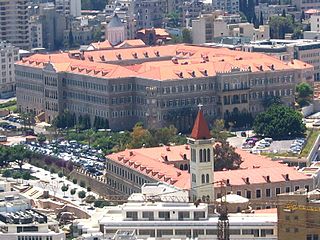
The Phoenician port of Beirut, also known as the Phoenician Harbour of Beirut and archaeological site BEY039 is located between Rue Allenby and Rue Foch in Beirut, Lebanon. Studies have shown that the Bronze Age waterfront lay around 300 metres (330 yd) behind the modern port due to coastal regularisation and siltation. It was excavated and reported on by Josette Elayi and Hala Sayegh in 2000 and determined to date to the Iron Age III and Persian periods. Two nineteenth-century Ottoman docks were also unearthed during construction, just to the north of this area at archaeological sites BEY018 and BEY019.
The Association for the Protection of the Lebanese Heritage or APLH is a cultural heritage, non-governmental organization based in Zouk Mosbeh, Keserwan District of Mount Lebanon, Lebanon.
Arsal, is a town and municipality situated east of Labweh, 124 kilometres (77 mi) northeast of Beirut, in Baalbek District of Baalbek-Hermel Governorate, Lebanon. The population is predominantly Sunni Muslim.

The Roman Forum is located in Beirut, Lebanon.
References
- 1 2 "Archaeology and History of Lebanon". Archaeology and History of Lebanon-journal. Archived from the original on December 14, 2007. Retrieved April 17, 2008.
- ↑ Claude Doumet-Serhal (1 March 2004). Decade: A Decade of Archaeology and History in the Lebanon. Lebanese British Friends of the National Museum. ISBN 978-2-913330-34-4 . Retrieved 22 September 2012.
- ↑ Jean-Paul Rey-Coquais (2010). Christian Footprints in the Lebanon$Jean-Paul Rey-Coquais ... Lebanese British Friends of the National Museum. Retrieved 22 September 2012.
- ↑ Lebanese-British Friends of the National Museum have a party, The Daily Star Lebanon, 19 November, 2008.